- Airport diagrams
Descent Briefing:
- Review each step to be performed, including but not limited to:
- Frequencies needed and information required for radio calls (i.e., ATIS information, requests)
- Type of landing to be performed
- Key airspeeds to hit
- Roll-out and runway exit plan
- Taxi plan/request (pending ATC instructions)
- Parking plan
Descent/Flow Checklist:
- Check that the mixture is full rich
- Turn on the fuel pump
- Put on shoulder harnesses
- This should include a quick briefing of the airport (i.e., runway vs. taxiway orientation to avoid a wrong surface landing) where an approach and landing procedure being conducted
Initial Contact:
- Remember, when flying an instrument approach, approach control may clear you for an approach, but the tower clears you to land
- To provide controllers with the information they need to clear you to land, pilots must declare their intentions
- Intentions may be to conduct touch and go's, low approaches, or landing, and to where you will taxi to park
Normal Approach & Landing:
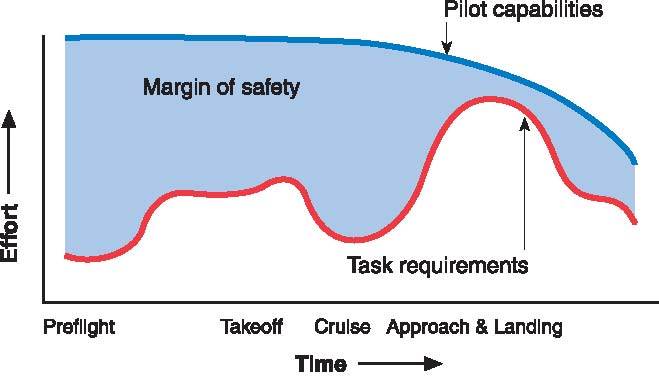
- Normal approaches and landings are the building blocks from which all other landings build
- While this procedure is for normal landing, assuming the wind is blowing right down the runway, that will rarely be the case
Normal Approach & Landing Procedure:
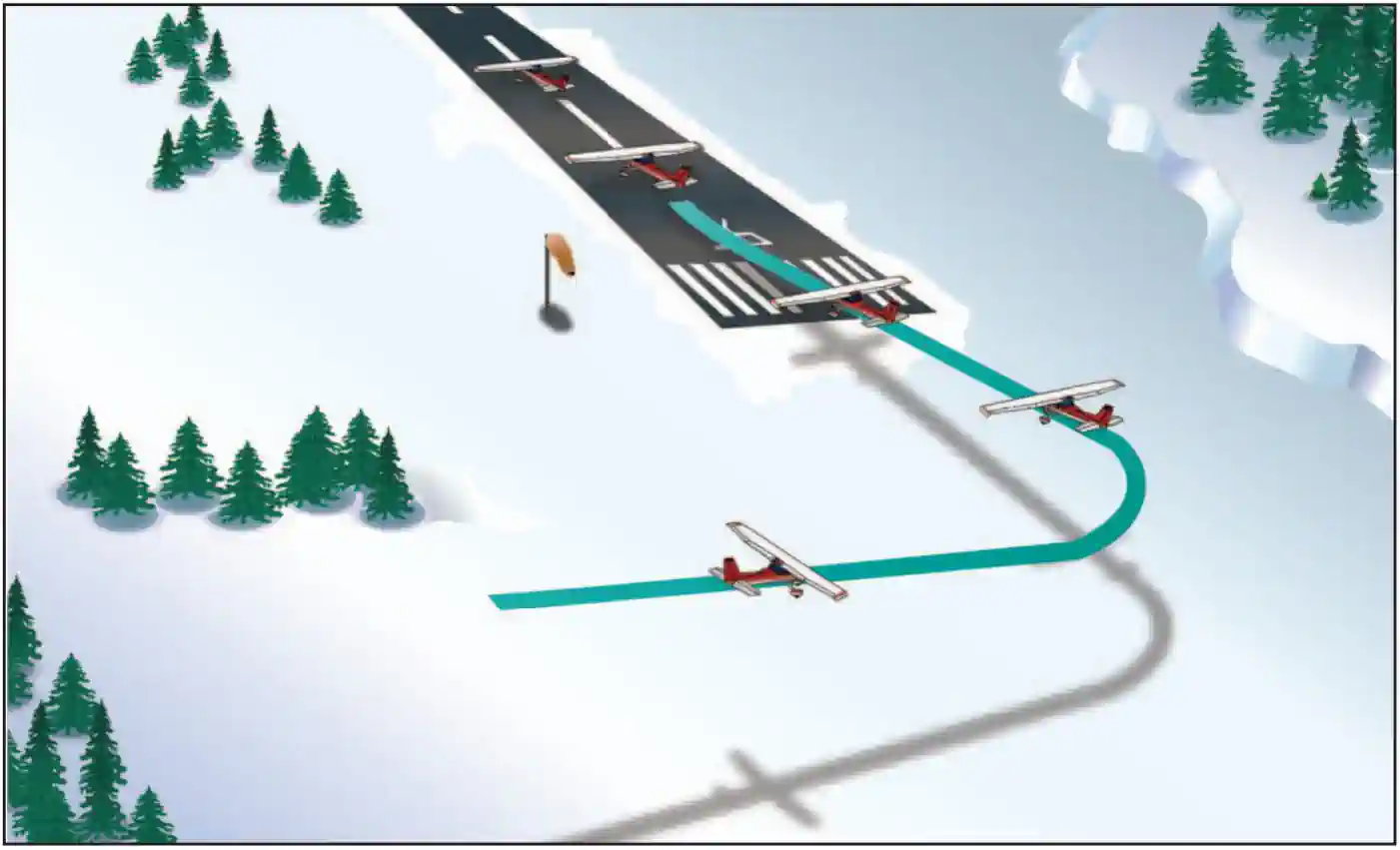
WARNING:
All procedures are GENERALIZED.
Always fly per Pilot Operating Handbook procedures,
observing any relevant Standard Operating Procedures (SOPs)- Complete the Descent Flows/Checklists
- This should include a quick briefing of the airport (i.e., runway vs. taxiway orientation to avoid a wrong surface landing) where an approach and landing procedure being conducted
- Gather any documents you may want to have ready during the approach or immediately after landing
- Talk to the tower as appropriate to the airspace you're operating within
- Controlled: " [Tower] , [Callsign] , [Location] , [Information] , [Intentions] "
- Example: " Palms tower, Cessna One Seven Two Seven Victor, fives miles to the west for touch and go's "
- Uncontrolled: " [Facility Name] , [Callsign] , [Location] , [Information] , [Intentions] , [Facility Name] "
- Example: " Palms tower, Cessna one seven two seven victor, five miles to the west for touch and goes, palms tower "
- Controlled: " [Tower] , [Callsign] , [Location] , [Information] , [Intentions] "
- Abide by the tower's instructions and plan to enter the traffic pattern at Traffic Pattern Altitude (TPA) on a 45° entry to the downwind, maintaining a one-half mile distance from the runway on the downwind leg
- Alternatively, if approved, you may enter the pattern through the overhead approach maneuver
- Set power to establish and maintain traffic pattern speed
- Abeam the point of intended landing, reduce power , lower the landing gear, set the flaps , and begin a gentle descent and call
- Keeping your hand on the landing gear until given the down and locked indication will prevent forgetting
- Controlled: " [Tower] , [Callsign] abeam, gear 3 down and locked, [Landing Type] "
- ATC: " [Callsign] , [Winds] , cleared for [Runway] , [Landing Type] "
- ATC: Cessna 1727V, wind 130 at 5 knots, runway 12, cleared to land
- Uncontrolled: None
- Anticipate the balloon effect when lowering the flaps
- Trim as necessary
- At the 45° point to the intended touchdown point, commence a turn to the base leg
- ICS: " Cleared left, forward, clear right, turning [Left/Right] "
- Controlled: None
- Uncontrolled: " [Facility Name] , [Callsign] , turning base for [Runway] , [Facility Name] "
- The wind is now at your side, so depending on its strength, you will need to compensate for drift with a crab angle
- Set the flaps , then establish and maintain base leg airspeed
- Anticipate the balloon effect when lowering the flaps
- Trim as necessary
- Visually verify that the final approach (including the extended final and the opposite base leg) is clear, and turn final
- ICS: " Cleared left, forward, clear right, turning [Left/Right] "
- Controlled: None
- Uncontrolled: " [Facility Name] , [Callsign] , turning base for [Runway] , [Facility Name] "
- Check your heading indicator against the runway heading to ensure you're lined up with the correct runway
- Be mindful of wake turbulence considerations
- That is look for larger, slower, heavier aircraft and offset your flight path higher & upwind)
- ATC will generally include " caution wake turbulence " before giving winds when clearing an aircraft to land
- When landing is assured, set the flaps for landing and establish approach speed
- Anticipate the balloon effect when lowering the flaps
- Trim as necessary
- Shift your scan to the glideslope indicators, if available, runway alignment, airspeed, and VSI
- By 300' above landing, complete a GUMP check
- GUMP Check:
- Gas: Fuel Selector and Pumps - SET
- Undercarriage: Gear - DOWN AND LOCKED (if applicable)
- Mixture: Mixture - FULL FORWARD
- Prop: Prop - FULL FORWARD (if applicable)
- If the approach is stabilized, call out, " 300 feet, stabilized, continuing "
- If the approach is not stabilized, callout, " 300 feet, not stabilized, going around, " and execute a go-around
- When descending beneath area obstructions like buildings, trees, or otherwise, be prepared for wind shifts
- GUMP Check:
- Approaching the runway threshold, verify the runway number (heading) matches your clearance
- You are checking to verify you are landing on the correct runway as this is your last opportunity to wave off
- As you cross the threshold, begin reducing power as necessary to "roundout" and transitioning to the flare, holding the airplane 1-2 feet off the surface in ground effect, now at idle, as long as possible (to gradually dissipate forward speed)
- When within 10-20 feet, about the height of a hangar, begin the roundout
- Don't focus on the runway, but instead look long (at least a few hundred feet) to flare
- You will see the horizon flatten as if you're sitting on the ground
- Avoid closing the throttle so rapidly that an immediate increase in the rate of descent leads to a hard landing
- Touch down at minimum controllable airspeed with a power-off stall pitch attitude on the main wheels first (minimum float) and with the throttle at the idle (closed) position
- Hold the nose wheel off with back pressure throughout the roll-out; allowing settling gently
- Increase aileron deflection into the wind if present or has shifted from expected
- Maintain directional control throughout the roll-out with the rudder, slowing sufficiently before turning on a taxiway
- Exit the runway without delay at the first available taxiway or on a taxiway as instructed by ATC
- An aircraft is considered clear of the runway when all parts of the aircraft are past the runway edge and there are no restrictions to its continued movement beyond the runway holding position markings
- Proceed with taxi procedures
-
Normal Approach and Landing Common Errors:
- Inadequate wind drift correction on the base leg
- Overshooting or undershooting the turn onto the final approach, resulting in too steep or too shallow a turn onto the final approach
- Flat or skidding turns from base leg to final approach as a result of overshooting/inadequate wind drift correction
- Poor coordination during the turn from base to final approach
- Failure to complete the landing checklist in a timely manner
- Un-stabilized approach
- Failure to adequately compensate for flap extension
- Poor trim technique on the final approach
- Attempting to maintain altitude or reach the runway using the elevator alone
- Focusing too close to the airplane, resulting in too high a round-out
- Focusing too far from the airplane, resulting in too low a round-out
- Touching down before attaining a proper landing attitude
- Failure to hold sufficient back-elevator pressure after touchdown
- Excessive braking after touchdown
Normal Takeoff and Climb Airman Certification Standards:
- Objective: To determine the applicant exhibits satisfactory knowledge, risk management, and skills associated with normal approach and landing with emphasis on proper use and coordination of flight controls
- Note: If a crosswind condition does not exist, the applicant’s knowledge of crosswind elements must be evaluated through oral testing
- References: AIM; FAA-H-8083-2 (Risk Management Handbook), FAA-H-8083-3 (Airplane Flying Handbook), FAA-H-8083-23 (Seaplane, Skiplane, and Float/Ski Equipped Helicopter Operations Handbook), FAA-H-8083-25 (Pilot Handbook of Aeronautical Knowledge); POH/AFM
- Private Pilot - Normal Approach and Landing Lesson Plan
Normal Approach and Landing Knowledge:
PA.IV.B.K1:
PA.IV.B.K2:
PA.IV.B.K3:
Normal Approach and Landing Risk Management:
PA.IV.B.R1:
PA.IV.B.R2:
PA.IV.B.R2a:
PA.IV.B.R2b:
PA.IV.B.R2c:
PA.IV.B.R2d:
PA.IV.B.R2e:
PA.IV.B.R3:
PA.IV.B.R3a:
PA.IV.B.R3b:
PA.IV.B.R4:
PA.IV.B.R5:
PA.IV.B.R6:
Normal Approach and Landing Skills:
PA.IV.B.S1:
PA.IV.B.S2:
PA.IV.B.S3:
PA.IV.B.S4:
PA.IV.B.S5:
PA.IV.B.S6:
PA.IV.B.S7:
PA.IV.B.S8:
PA.IV.B.S9:
PA.IV.B.S10:
PA.IV.B.S11:
PA.IV.B.S12:
Commercial Pilot (Airplane) Normal Approach and Landing Airman Certification Standards:
- Objective: To determine the applicant exhibits satisfactory knowledge, risk management, and skills associated with normal approach and landing with emphasis on proper use and coordination of flight controls
- Note: If a crosswind condition does not exist, the applicant’s knowledge of crosswind elements must be evaluated through oral testing
- References: AIM; FAA-H-8083-2 (Risk Management Handbook), FAA-H-8083-3 (Airplane Flying Handbook), FAA-H-8083-23 (Seaplane, Skiplane, and Float/Ski Equipped Helicopter Operations Handbook), FAA-H-8083-25 (Pilot Handbook of Aeronautical Knowledge); POH/AFM
- Commercial Pilot (Airplane) Normal Approach and Landing Lesson Plan
Commercial Pilot (Airplane) Normal Approach and Landing Knowledge:
CA.IV.B.K1:
CA.IV.B.K2:
CA.IV.B.K3:
Commercial Pilot (Airplane) Normal Approach and Landing Risk Management:
CA.IV.B.R1:
CA.IV.B.R2:
CA.IV.B.R2a:
CA.IV.B.R2b:
CA.IV.B.R2c:
CA.IV.B.R2d:
CA.IV.B.R2e:
CA.IV.B.R3:
CA.IV.B.R3a:
CA.IV.B.R3b:
CA.IV.B.R4:
CA.IV.B.R5:
CA.IV.B.R6:
Commercial Pilot (Airplane) Normal Approach and Landing Skills:
CA.IV.B.S1:
CA.IV.B.S2:
CA.IV.B.S3:
CA.IV.B.S4:
CA.IV.B.S5:
CA.IV.B.S6:
CA.IV.B.S7:
CA.IV.B.S8:
CA.IV.B.S9:
CA.IV.B.S10:
CA.IV.B.S11:
CA.IV.B.S12:
Crosswind Approach and Landing:
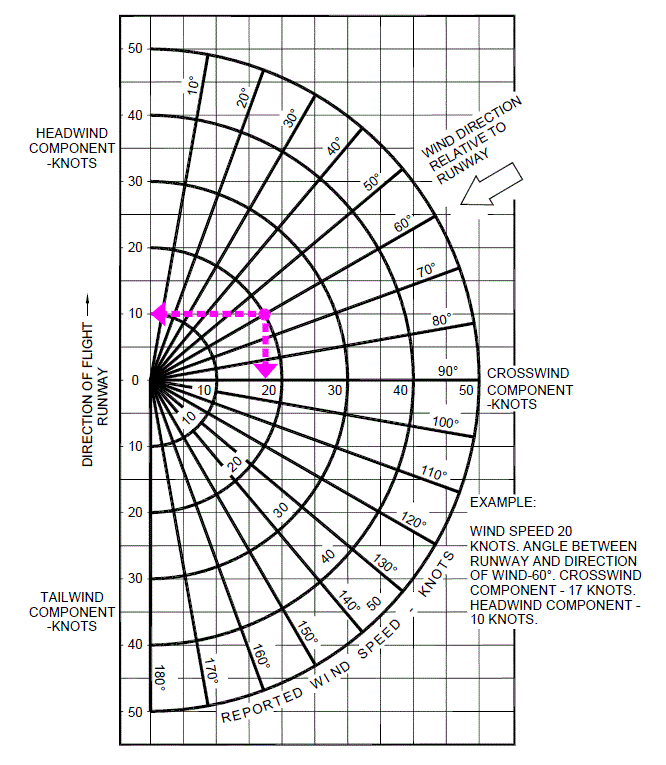
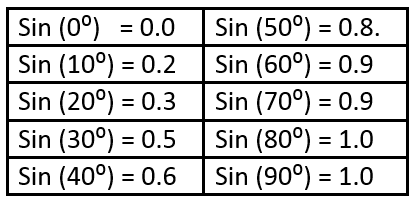
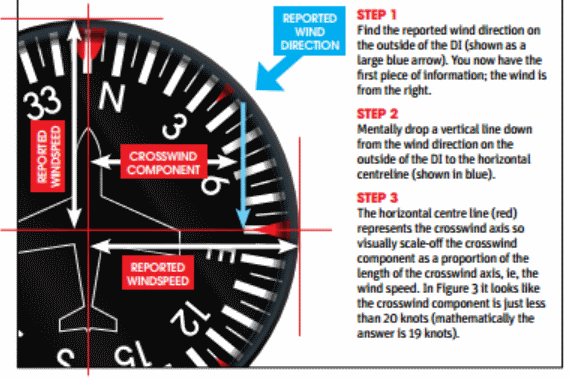
- The goal of a crosswind landing is to safely and accurately establish and maintain a stabilized approach to landing, correcting for a crosswind during the approach, touchdown, and roll-out

Determining Crosswind Component:
- Crosswinds can be determined through several methods, which each serve a purpose, depending on the phase of flight
- When calculating the crosswind, always use the full gust component, meaning calculate crosswind as a "worst case" scenario
Chart Method:
- Crosswind charts can be found in nearly every POH/PIM but are not aircraft-specific, so any will do
- Using the example provided in [ Figure 1 ], plot your point using the number of degrees off the runway heading, with the full gust component as strength
- Let's say we're going to land at runway 360, and the wind is coming from 020 at 20 knots
- We'll plot the wind strength at the 20° radial line (representing 20° off the runway) on the 20° point (representing the wind strength)
- From the plotted point we move straight left for the headwind component: roughly 19 knots
- We can also move straight down for the crosswind component: roughly 6 knots
Heading Indicator Rule of Thumb:
- Find the reported wind direction on the outside of the DI (shown as a large blue arrow). You now have the first piece of information; the wind is from the right [ Figure 2/3 ]
- Mentally drop a vertical line down from the wind direction on the outside of the DI to the horizontal centerline (shown in blue)
- The horizontal center line (red) represents the crosswind axis, so visually scale off the crosswind component as a proportion of the length of the crosswind axis, i.e., the wind speed
- Using our example, this means our crosswind component is just less than 20 knots (mathematically, the answer is 19 knots)
Sixths Rules of Thumb:
- If angle = 10 deg, then crosswind component = 1/6 wind strength
- If angle = 20 deg, then crosswind component = 2/6 (1/3) wind strength
- If angle = 30 deg, then crosswind component = 3/6 (1/2) wind strength
- If angle = 40 deg, then crosswind component = 4/6 (2/3) wind strength
- If angle = 50 deg, then crosswind component = 5/6 wind strength
- If angle = 60+ deg, then crosswind component = wind strength
Additional Methods:
- Additional methods of calculating crosswind components exist; however, they may not be as prudent for use during approach and landing as they would for other phases of flight, such as takeoff
- They include:
- Mathematical Formula
Crosswind Compensation Techniques:
Slip:
- A slip is a cross-control procedure where you are using "wing-low, top-rudder" to track the aircraft straight for the purposes of altitude loss (forward-slip) or crosswind compensation (side-slip)
- In doing this, you will need to lower the nose as the increase in drag without an increase in thrust will cause a rapid loss of airspeed, risking a stall
- Simply stated, the higher the angle of bank, the lower the nose must be
- A forward-slip allows pilots to increase the aircraft's rate of descent without increasing airspeed in the process
- A side-slip, however, allows pilots to compensate for a crosswind on final approach
Side-slip:
- A side-slip is used to compensate for a crosswind on final approach
- First, you apply the aileron into the wind to compensate for the crosswind blowing you off centerline
- Next, you use the rudder to maintain alignment with the runway centerline
- Think: "Point your nose with your toes"
- The horizontal component of lift forces the airplane to move sideways toward the low-wing
- The aircraft's rudder is used to align to the center while the wings are dripped (toward the wind) to maintain track (drift)
- Held all the way to touchdown, this will result in the low side wheel touching down first, followed by the high wheel, and lastly, the nose/tail wheel
- Note that when performing a slip, the Pilot Operating Handbook may impose certain restrictions such as:
- Avoiding slips with full flaps
- Avoiding slips for prolonged periods, which may result in fuel ports becoming uncovered
- Airspeed indications may vary due to static ports receiving direct wind
- If your static port is located on the left side of the fuselage, a slip using the right rudder will cause the perceived static pressure to be higher than actual as ram air is forced into the static port, resulting in your indicated airspeed being less than actual. Therefore, it would normally be advisable to maintain an airspeed comfortably within the middle range of the white arc (flap operating range) to avoid being either too close to a cross-control stall or a flap over-speed condition
- Ensure to check POH for side-slip limitations, as some aircraft do not allow them with full flaps
-
Crab:
- Coordinated flight whereby you are pointing the nose of the aircraft upwind enough to keep the airplane's ground track straight
- The angle by which the aircraft is flying relative to the runway is considered the crosswind correction
- It is most preferable, in general aviation, to fly a crab and transition to a slip for landing to avoid side-loading the landing gear
- At some point during the final approach, a transition from crab to side-slip for the landing flare and touchdown should be made
-
Gust Factor:
- On all approaches, but especially crosswind approaches, you'll want to determine the gust factor
- Gust factors are agnostic to the wind direction
- To calculate, take your gusts and subtract them from the sustained wind
- If your wind is 10 knots and the gusts are 20, then we can subtract 20 from 10 to get 10 as our gust factor
Crosswind Control Mechanics:
- Crab on a final and slip to the landing
- The aircraft will want to weathervane, pointing into the wind
- The rudder is necessary to maintain directional control
- The crosswind effect will never completely disappear, meaning that some input will remain
- This side-skipping imposes severe side stresses on the landing gear and could result in structural failure
Crosswind Approach & Landing Procedure:
- Complete the Descent Flows/Checklists
- This should include a quick briefing of the airport (i.e., runway vs. taxiway orientation to avoid a wrong surface landing) where an approach and landing procedure being conducted
- Gather any documents you may want to have ready during the approach or immediately after landing
- Talk to the tower as appropriate to the airspace you're operating within
- Controlled: " [Tower] , [Callsign] , [Location] , [Information] , [Intentions] "
- Example: " Palms tower, Cessna One Seven Two Seven Victor, fives miles to the west for touch and go's "
- Uncontrolled: " [Facility Name] , [Callsign] , [Location] , [Information] , [Intentions] , [Facility Name] "
- Example: " Palms tower, Cessna one seven two seven victor, five miles to the west for touch and goes, palms tower "
- Abide by the tower's instructions and plan to enter the traffic pattern at Traffic Pattern Altitude (TPA) on a 45° entry to the downwind, maintaining a one-half mile distance from the runway on the downwind leg
- Alternatively, if approved, you may enter the pattern through the overhead approach maneuver
- Controlled: " [Tower] , [Callsign] , [Location] , [Information] , [Intentions] "
- Set power to establish and maintain traffic pattern speed
- Abeam the point of intended landing, reduce power , set the flaps , lower the landing gear, and begin a gentle descent and call
- Keeping your hand on the landing gear until given the down and locked indication will prevent forgetting
- Controlled: " [Tower] , [Callsign] abeam, gear 3 down and locked, [Landing Type] "
- ATC: " [Callsign] , [Winds] , cleared for [Runway] , [Landing Type] "
- Uncontrolled: None
- Anticipate the balloon effect when lowering the flaps
- Trim as necessary
- At the 45° point to the intended touchdown point (or as appropriate for wind conditions), commence a turn to the base leg
- ICS: " Cleared left, forward, clear right, turning [Left/Right] "
- Controlled: None
- Uncontrolled: " [Facility Name] , [Callsign] , turning base for [Runway] , [Facility Name] "
- The wind is now at your side, so depending on its strength, you will need to compensate for drift with a crab angle
- Set the flaps , then establish and maintain base leg airspeed
- Anticipate the balloon effect when lowering the flaps
- Trim as necessary
- Visually verify that the final approach (including the extended final and the opposite base leg) is clear, and turn final
- ICS: " Cleared left, forward, clear right, turning [Left/Right] "
- Controlled: None
- Uncontrolled: " [Facility Name] , [Callsign] , turning base for [Runway] , [Facility Name] "
- Check your heading indicator against the runway heading to ensure you're lined up with the correct runway
- Be mindful of wake turbulence considerations
- That is look for larger, slower, heavier aircraft and offset your flight path higher & upwind)
- When landing is assured, set the flaps for landing and establish approach speed (+1/2 gust factor, if applicable)
- Anticipate the balloon effect when lowering the flaps
- Trim as necessary
- Transition from a crab to a slip
- Shift your scan to the glideslope indicators, if available, runway alignment, airspeed, and VSI
- By 300' above landing, complete a GUMP check
- GUMP Check:
- Gas: Fuel Selector and Pumps - SET
- Undercarriage: Gear - DOWN AND LOCKED (if applicable)
- Mixture: Mixture - FULL FORWARD
- Prop: Prop - FULL FORWARD (if applicable)
- If the approach is stabilized, call out, " 300 feet, stabilized, continuing "
- If the approach is not stabilized, callout, " 300 feet, not stabilized, going around, " and execute a go-around
- When descending beneath area obstructions like buildings, trees, or otherwise, be prepared for wind shifts
- GUMP Check:
- Approaching the runway threshold, verify the runway number (heading) matches your clearance
- You are checking to verify you are landing on the correct runway, as this is your last opportunity to go-around
- As you cross the threshold, begin reducing power as necessary to "roundout" and transitioning to the flare, holding the airplane 1-2 feet off the surface in ground effect, now at idle, as long as possible (to gradually dissipate forward speed)
- When within 10-20 feet, about the height of a hangar, begin the roundout
- Don't focus on the runway, but instead look long (at least a few hundred feet) to flare
- You will see the horizon flatten as if you're sitting on the ground
- Avoid closing the throttle so rapidly that an immediate increase in the rate of descent leads to a hard landing
- Touch down at minimum controllable airspeed with a power-off stall pitch attitude on the main wheels first (minimum float) and with the throttle at the idle (closed) position
- Hold the nose wheel off with back pressure throughout the roll-out; allowing settling gently
- Once the aircraft touches down, it will tend to find the centerline on its own; you need to be judicious with your inputs to avoid any induced oscillations
- Subsequent runway centerline tracking requires only small rudder inputs to initiate directional corrections
- Increase aileron deflection into the wind as you decelerate due to less airflow, decreasing aileron effectiveness
- Maintain directional control throughout the roll-out with the rudder, slowing sufficiently before turning on a taxiway
- Remember to maintain taxi control inputs for winds
- Exit the runway without delay at the first available taxiway or on a taxiway as instructed by ATC
- An aircraft is considered clear of the runway when all parts of the aircraft are past the runway edge, and there are no restrictions to its continued movement beyond the runway holding position markings
- Proceed with taxi procedures
-
Crosswind Approach and Landing Common Errors:
- Attempting to land in crosswinds that exceed the airplane's maximum demonstrated crosswind component
- Inadequate compensation for wind drift on the turn from base leg to final approach, resulting in under or shooting
- Flat or skidding turns from base leg to final approach as a result of overshooting/inadequate wind drift correction
- Poor coordination during the turn from base to final approach
- Failure to complete the landing checklist in a timely manner
- Un-stabilized approach
- Inadequate compensation for wind drift on the final approach
- Maintaining too much speed on the final approach to compensate for winds
- Failure to adequately compensate for flap extension
- Poor trim technique on the final approach
- Failure to compensate for increased drag during side-slip, resulting in excessive sink rate and/or too low an airspeed
- Attempting to maintain altitude or reach the runway using the elevator alone
- Focusing too close to the airplane, resulting in too high a round out
- Focusing too far from the airplane, resulting in too low a round out
- Touching down before attaining a proper landing attitude
- Failure to apply appropriate flight control inputs during roll-out, causing the aircraft to drift, weathervane, or lean
- Failure to maintain directional control on roll-out
- Touchdown while drifting
- Excessive airspeed on touchdown, resulting in a late touchdown
- Excessive braking after touchdown
- Slip:
- Failure to reduce power to idle
- Failure to add or increase flaps when available
- Failure to apply and maintain full rudder deflection
- Failure to use appropriate rudder/aileron combination during a crosswind situation
- Failure to reduce pitch to maintain proper safe gliding airspeed
Short-Field Approach and Landing:
- The goal of the short-field approach and landing is to maximize aircraft performance to safely and accurately land when runway distance is limited
- The approach is made with minimum engine power commensurate with flying towards the aiming point on the runway
- This will result in a steeper approach than otherwise flown with other landing procedures
- The speed must be reduced progressively as the aircraft's height reduces, and after reaching the airspeed for the final approach, it must be maintained accurately
- After touchdown, the pilot applies maximum wheel braking and maximum up-elevator to minimize distance traveled
- Wing-flaps are sometimes retracted to allow better braking performance
- Tips:
- Touchdown as close to the approach end as safely possible
- Utilize maximum braking available
- Keep tires on the ground to keep friction
- Land into a headwind
- Land as the lowest weight possible
Short-Field Approach & Landing Procedure:
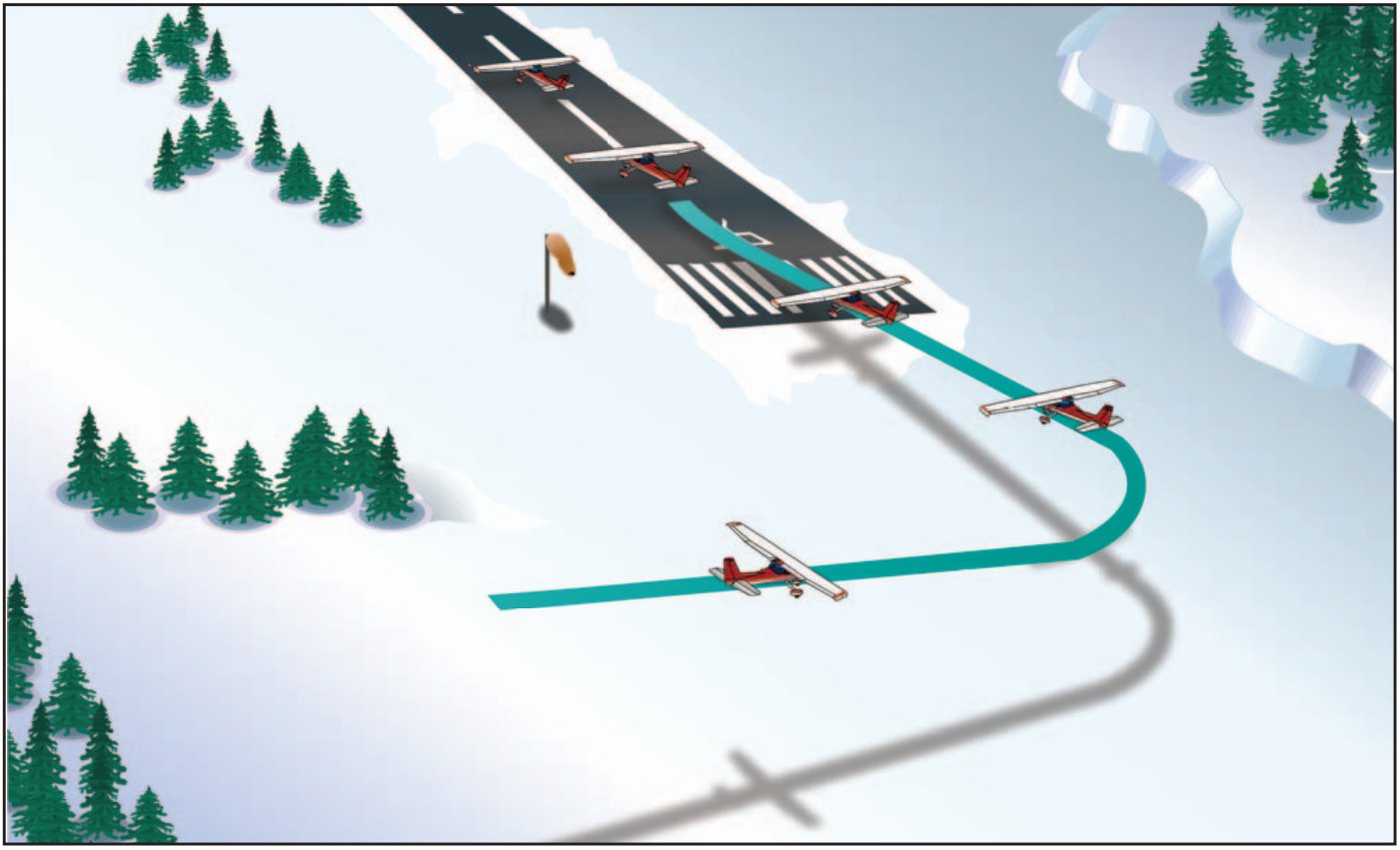
- Complete the Descent Flows/Checklists
- This should include a quick briefing of the airport (i.e., runway vs. taxiway orientation to avoid a wrong surface landing) where, and approach and landing procedure being conducted
- Gather any documents you may want to have ready during the approach or immediately after landing
- Talk to the tower as appropriate to the airspace you're operating within
- Controlled: " [Tower] , [Callsign] , [Location] , [Information] , [Intentions] "
- Example: " Palms tower, Cessna one seven two seven victor, fives miles to the west for touch and go's "
- Uncontrolled: " [Facility Name] , [Callsign] , [Location] , [Information] , [Intentions] , [Facility Name] "
- Example: " Palms tower, Cessna One Seven Two Seven Victor, five miles to the west for touch and goes, palms tower "
- Abide by the tower's instructions and plan to enter the traffic pattern at Traffic Pattern Altitude (TPA) on a 45° entry to the downwind, maintaining a one-half mile distance from the runway on the downwind leg
- Alternatively, if approved, you may enter the pattern through the overhead approach maneuver
- Controlled: " [Tower] , [Callsign] , [Location] , [Information] , [Intentions] "
- Set power to establish and maintain traffic pattern speed
- Abeam the point of intended landing, reduce power , lower the landing gear, set the flaps , begin a gentle descent , and call
- Keeping your hand on the landing gear until given the down and locked indication will prevent forgetting
- Controlled: " [Tower] , [Callsign] abeam, gear 3 down and locked, [Landing Type] "
- ATC: " [Callsign] , [Winds] , cleared for [Runway] , [Landing Type] "
- Uncontrolled: None
- Anticipate the balloon effect when lowering the flaps
- Trim as necessary
- At the 45° point to the intended touchdown point (or as appropriate for wind conditions), commence a turn to the base leg
- ICS: " Cleared left, forward, clear right, turning [Left/Right] "
- Controlled: None
- Uncontrolled: " [Facility Name] , [Callsign] , turning base for [Runway] , [Facility Name] "
- The wind is now at your side, so depending on its strength, you will need to compensate for drift with a crab angle
- Set the flaps , then establish and maintain base leg airspeed
- Anticipate the balloon effect when lowering the flaps
- Trim as necessary
- Visually verify that the final approach (including the extended final and the opposite base leg) is clear, and turn final
- ICS: " Cleared left, forward, clear right, turning [Left/Right] "
- Controlled: None
- Uncontrolled: " [Facility Name] , [Callsign] , turning base for [Runway] , [Facility Name] "
- Check your heading indicator against the runway heading to ensure you're lined up with the correct runway
- Be mindful of wake turbulence considerations
- That is look for larger, slower, heavier aircraft and offset your flight path higher & upwind)
- When landing is assured, set the flaps for landing and establish approach speed (+1/2 gust factor, if applicable)
- Anticipate the balloon effect when lowering the flaps
- Trim as necessary
- Transition from a crab to a slip
- Shift your scan to the glideslope indicators, if available, runway alignment, airspeed, and VSI
- By 300' above landing, complete a GUMP check
- GUMP Check:
- Gas: Fuel Selector and Pumps - SET
- Undercarriage: Gear - DOWN AND LOCKED (if applicable)
- Mixture: Mixture - FULL FORWARD
- Prop: Prop - FULL FORWARD (if applicable)
- If the approach is stabilized, call out, " 300 feet, stabilized, continuing "
- If the approach is not stabilized, callout, " 300 feet, not stabilized, going around, " and execute a go-around
- When descending beneath area obstructions like buildings, trees, or otherwise, be prepared for wind shifts
- GUMP Check:
- Approaching the runway threshold, verify the runway number (heading) matches your clearance
- You are checking to verify you are landing on the correct runway, as this is your last opportunity to go-around
- As you cross the threshold, begin reducing power as necessary to "round-out" and transitioning to the flare, holding the airplane 1-2 feet off the surface in ground effect, now at idle, as long as possible (to gradually dissipate forward speed)
- When within 10-20 feet, about the height of a hangar, begin the roundout
- Don't focus on the runway, but instead look long (at least a few hundred feet) to flare
- You will see the horizon flatten as if you're sitting on the ground
- Avoid closing the throttle so rapidly that an immediate increase in the rate of descent leads to a hard landing
- Touch down at minimum controllable airspeed with a power-off stall pitch attitude on the main wheels first (minimum float) and with the throttle at the idle (closed) position
- Hold the nose wheel off with back pressure throughout the roll-out, settling gently
- Increase aileron deflection into the wind if present or has shifted from expected
- Increase "up" elevator to increase braking effectiveness
- At nose wheel touch down:
- Callout, "flaps up, max braking"
- Retract the flaps to the up (0°) position (for maximum braking effectiveness)
- Hold the control wheel full back, and
- Apply braking as necessary to stop within the shortest distance possible, consistent with safety and controllability
- Maintain directional control throughout the roll-out with the rudder, slowing sufficiently before turning on a taxiway
- Reference board speeds: you should be traveling no faster than twice the distance remaining
- Example: at the 3 board, you should be traveling no more than 60 knots
- If required, raise the flaps, which decreases lift over the wings and, therefore, increase weight on the brakes
- Exit the runway without delay at the first available taxiway or on a taxiway as instructed by ATC
- An aircraft is considered clear of the runway when all parts of the aircraft are past the runway edge, and there are no restrictions to its continued movement beyond the runway holding position markings
- Proceed with taxi procedures
-
Short-Field Approach & Landing Common Errors:
- Inadequate wind drift correction on the base leg
- Overshooting or undershooting the turn onto the final approach, resulting in too steep or too shallow a turn onto the final approach
- Flat or skidding turns from base leg to final approach as a result of overshooting/inadequate wind drift correction
- Poor coordination during the turn from base to final approach
- Failure to complete the landing checklist in a timely manner
- Un-stabilized approach
- Failure to adequately compensate for flap extension
- Poor trim technique on the final approach
- Attempting to maintain altitude or reach the runway using elevator control alone
- Focusing too close to the airplane, resulting in too high a round-out
- Focusing too far from the airplane, resulting in too low a round-out
- Touching down before attaining a proper landing attitude
- Failure to hold sufficient back-elevator pressure after touchdown
- Excessive and/or unnecessary braking after touchdown
- A final approach that necessitates an overly steep approach and high sink rate
- Undue delay in initiating glide path corrections
- Airspeed too low on final resulting in inability to flare properly and landing hard
- Too high an airspeed resulting in floating on round out
- Prematurely reducing power to idle on round out resulting in hard landing
- Touchdown with excessive airspeed
- Failure to maintain directional control
- Failure to recognize and abort a poor approach that cannot be completed safely
Private Pilot - Short-Field Approach and Landing (ASEL):
- Objective: To determine the applicant exhibits satisfactory knowledge, risk management, and skills associated with short-field approach and landing with emphasis on proper use and coordination of flight controls
- References: AIM; FAA-H-8083-2 (Risk Management Handbook), FAA-H-8083-3 (Airplane Flying Handbook), FAA-H-8083-25 (Pilot Handbook of Aeronautical Knowledge); POH/AFM
- Short-field approach and landing lesson plan